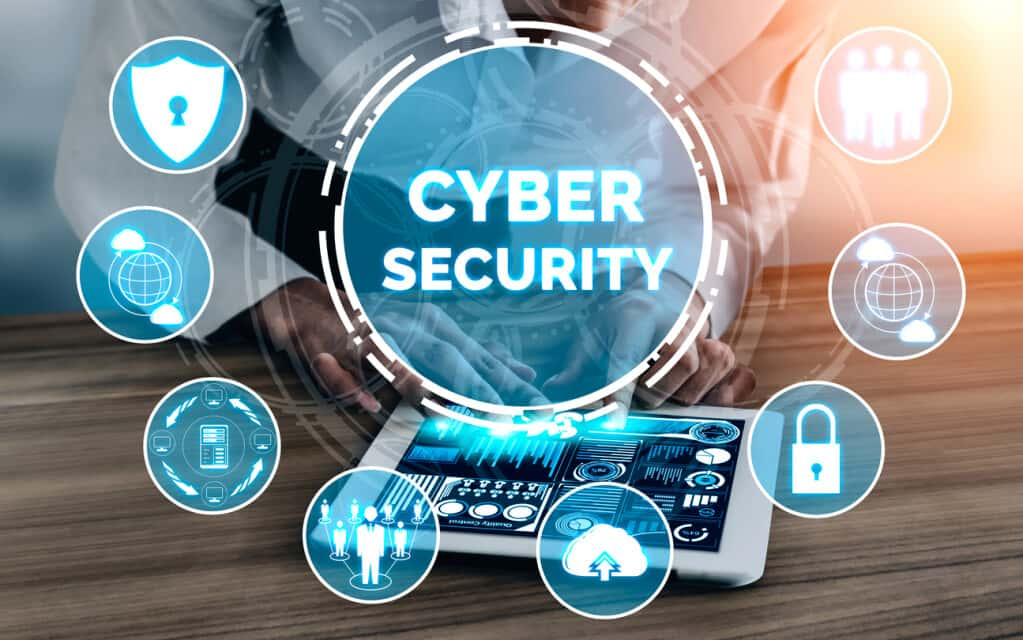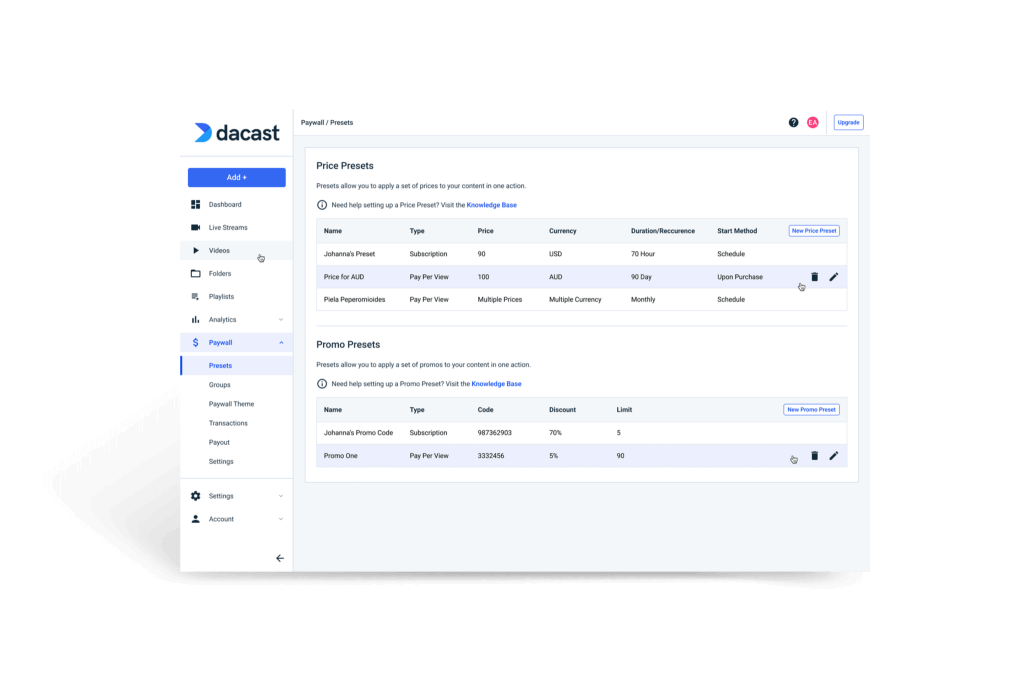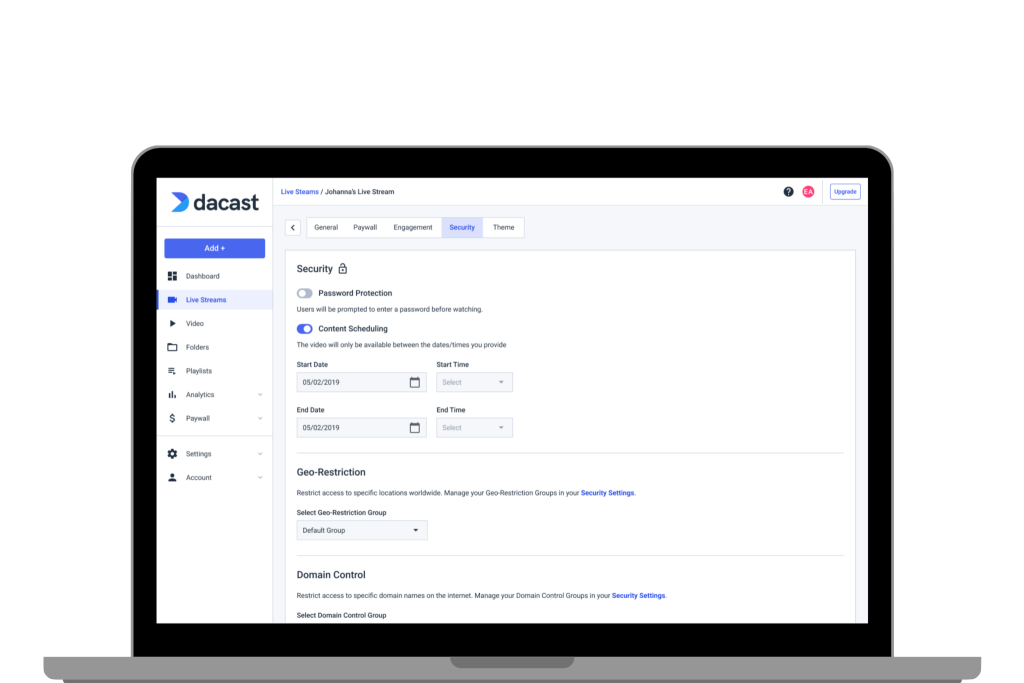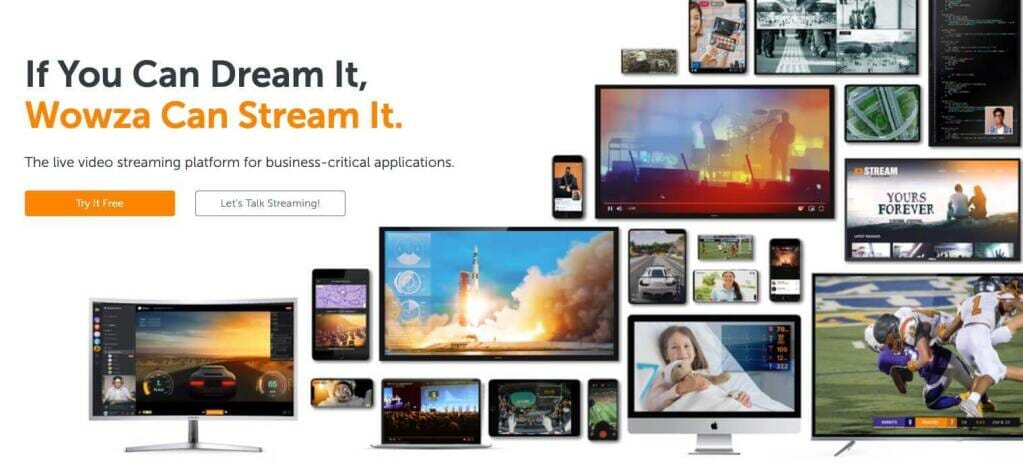The 10 Best Secure Video Streaming Platforms (+7 Methods ) For Professionals in 2025
Today, secure video streaming methods and platforms are crucial for businesses to ensure the confidentiality and integrity of sensitive content. Secure video streaming leverages encrypted video streaming and secure video players to protect data from unauthorized access. And with the rise of remote work and virtual events, encrypted live streaming has become paramount for maintaining secure communications during live broadcasts.
By utlizing secure streaming sites and encrypted streaming technologies, businesses can safeguard their media assets from potential threats. Furthermore, encrypted video players enhance video streaming security by preventing data breaches and ensuring secure video playback. By implementing these advanced security measures, companies can confidently share information and conduct secure live streams.
In this post, we’ll focus on secure video hosting and delivery. Specifically, we’ll examine seven important business video hosting methods, tools, and features. As a professional broadcaster, you should look for video hosting services that include all the features we list here and more.
Table of Contents
- Top 7 Secure Video Streaming Methods
- Additional Secure Streaming Tips
- Comparing The 10 Best Secure Video Streaming Platforms in 2025
- Conclusion
Top 7 Secure Video Streaming Methods

Not every secure video delivery method is created equal. The measures you use will depend on the purpose of your content, your target audience, and your goal with broadcasting.
For example, you wouldn’t put a password on video content that you’re trying to spread to the masses, but you would likely use another security method to make sure that the video player and sensitive information are not compromised in any way.
However, if you were sharing an internal training video, you would use a password to protect the content.
There are multiple methods to establish secure streaming.
Let’s dive into seven of the top secure streaming and private video-sharing methods for professional broadcasting.
1. AES Encryption
The first secure video streaming method we’ll cover here is AES encryption. AES stands for “Advanced Encryption Standard.” Encryption is a process of encoding information so that only authorized users can view it.
TechTarget defines AES as “a symmetric block cipher chosen by the U.S. government to protect classified information [and] implemented in software and hardware throughout the world to encrypt sensitive data.”
This sounds fancy, but basically, what it means is that AES encryption helps keep your content secure.
For streaming video, AES encryption secures each stream using a special key. Viewers need the correct digital access key to view the content. They can get this key in various ways, such as watching the video on an authorized website or signing in to view the video content. The viewer needs a secure HTTPS connection and a web browser.
Without this special key, viewers cannot watch the video. Without the key, the video would be a jumbled mess of mismatched visual and audio content.
In other words, AES makes it much harder for hackers to access your video content. Ultimately, hackers who intercept AES-encrypted secure video streams will be unable to watch the video.
This process is transparent to the users and easy to implement. There’s no learning curve, and turning on AES encryption with most online video platforms is as simple as checking a box.
AES encryption adds a strong layer of security to any professional video hosting solution. This security method can be combined with several other secure streaming measures to create a robust security solution for your content.
2. HTTPS Delivery
HTTPS protects you from so-called “man-in-the-middle” attacks. These attacks are relatively common with video streaming, especially when people use open networks at schools, coffee shops, and libraries to access video content.
Hackers can use vulnerabilities in these public networks to steal data as it’s being transmitted to the viewer.
Through digital certificates and encryption keys, HTTPS delivery uses HLS encryption to mask a user’s connection with the website and prevent this type of attack.
HTTPS wraps all communication between the server sending videos and the viewer through a layer of secure encryption. It provides additional protection to your content. HTTPS delivery is an excellent online video security method.
3. SSL/TLS Encrypted Paywall

Whenever customers enter payment information into your website, you need to ensure their data security. Otherwise, you could be liable for their damages and face major issues.
The best way to do this is via SSL/TLS. This is the same type of encryption that banks use to protect your financial data.
A secure video paywall ensures that you are protecting your customers’ data at all times. Therefore, it’s essential to use a secure paywall protected by SSL/TLS if you choose to monetize your video content.
Ideally, any paywall should also allow you to monetize video content and accept payment via multiple currencies and accept cards, PayPal, etc. When asking viewers for payment, you need to ensure you keep them safe.
4. Password-Protected Video
Although it seems simple, password-protected live streaming is a great way to protect your content from unqualified viewers.
Password-protected video works just like you would imagine. First, you set a password for the videos of your choice. Then viewers have to enter the correct password to watch. They can’t access the video if they don’t know the password.
Password protection is a simple, effective security method, one that’s perfect for preview videos, internal company use, client reviews, etc.
It’s also important to keep in mind that this is not an end-all-be-all line of defense. Depending on the scale of your brand, passwords may be leaked in online forums. For this reason, many broadcasters change passwords from time to time to keep forbidden access under wraps.
Password-protected video streaming is an effective way to help keep your content secure, especially when combined with other security features.
5. Geographic (IP) Restrictions
If your viewers are located within specific regions or countries, geographic or IP restrictions may be an option for you.
This tool aims to combat piracy by blocking certain geographic regions from accessing your videos. Most piracy comes from certain regions. The United States Office of the Trade Representative has reported that these 38 countries that have the highest rate of piracy for 2024. Geo-restrictions make it easy to “blacklist” these countries. That does mean cutting off access for all viewers from those countries though.
Many businesses only want to target their videos to viewers in one or two countries. In that case, geographic restrictions make it easy to “whitelist” these countries, automatically blacklisting everything else.
The whitelist works using IP addresses, which correspond to geographic location. Like most security measures, it’s not 100% bulletproof, but it can provide a valuable additional layer of security. If you know your target audience is located in a specific country, this can be a streaming security method you consider using.
6. Referrer Restrictions
Geo-restrictions work well, but as we’ve covered, the best way to ensure encrypted video streaming is through layers of security.
Another method you can implement to keep your content protected is referrer restrictions.
Referrer restrictions function by whitelisting certain domains that your video content is allowed to play on. Typically, these domains include your website and any partner websites you may have.
When enabled, this feature checks with the server regularly through a system of digital security tokens.
When it’s detected that your video is embedded on an unauthorized site, it will be immediately blocked from playback. Anyone who tries to embed your video on a different website will be unable to stream it.
7. Secure Video Data Centers and CDN
When you upload an online video to an online video platform, those files are stored in a data center, often run by a content delivery network (CDN).
A CDN is a network of servers that uses complex load-balancing software to deliver video and other media globally as fast as possible. A live-streaming CDN ensures your content loads quickly with minimal lagging and buffering.
Using an online video platform integrated with a CDN helps protect you against various attacks. This includes “DDoS” attacks, which flood a website with traffic to attempt to crash it. Using a CDN makes this type of cybersecurity attack largely ineffective.
Plus, CDNs help to protect you against hardware failure. They offer built-in redundancy, making your content safe and fast to load.
Additional Secure Streaming Tips
These seven security measures are quite effective. On top of using a secure video streaming service, multiple lines of defense is the way to go.
As we briefly mentioned before, a quick Google search of “your brand name + video title + password” should bring up any forums or websites that have leaked the credentials of password-protected content. This will let you know if you need to change any passwords.
Secure streaming is important, but so is the sensitive information that comes with professional broadcasting. If you monetize your content, your video CMS dashboard is associated with your financial information.
When you use video content for sales and marketing, you likely collect email addresses and contact information. You owe it to your leads to keep their information safe.
If possible, enable multi-factor authentication on any accounts that you use for professional broadcasting. This goes for your online video platform, your software encoder, the email address associated with your account, and any other tools you use.
Also, regularly update your software and plugins. Patches released can secure any security vulnerabilities. Furthermore, opt for secure live stream options that offer end to end encryption
Lastly, monitor your streams for any unusual or suspicious activity. This can often be the best way to prevent potential security issues.
Comparing the 10 Best Secure Video Streaming Platforms in 2025
With those encryption streaming features in mind, let’s review the top 10 secure streaming platforms.
Take a moment to review the features that each of these platforms offers. Identify which features are most important for your streaming goals.
Which features are non-negotiable? Are there ones you could afford to do without?
Let’s dive in.
1. Dacast

Dacast is a unified streaming solution that offers a wide variety of professional features. We offer both live streaming and video-on-demand platforms.
This platform is designed for broadcasters from enterprises, schools, and other professional organizations.
Basic Functionality
Dacast provides comprehensive live streaming and online video hosting services. Users can embed videos on their websites while maintaining 100% content control. Dacast offers an integrated paywall, password-protected video hosting, referrer restriction, and an analytics dashboard, among other features.
Dacast offers many advanced security features that can keep your videos secure while also offering features that make video streaming easier.
Global Content Delivery
Dacast works with top-level content delivery networks that can effectively deliver your content to a global audience, including China. Our top-level CDNs offer an additional layer of security for your video content.
Top-Level Video Security Features
Dacast offers a range of top-level video security features, starting with password protection, so you can control who accesses your content. Dacast also offers HLS and AES encryption for your content.
24/7 Tech Support
Part of a secure video streaming platform is access to the help you need when you need it. Dacast offers 24/7 tech support with all plans, including email and live chat support. If you have a security question or any question, someone will be standing by to help.
Quality End-User Experience
Dacast helps provide a quality end-user experience through adaptive multi-bitrate streaming. They also offer low latency HTML5 channels for video streaming, allowing you to provide the quality of your viewers with quality live streaming content.
Customizable Experience
You can create a customizable experience with Dacast using the player API access for 3rd party player integration and video API access on premium plans (event and scale).
We also offer a customizable video player that you can personalize with custom branding. You can also provide your viewers with ad-free streaming.
New!
- M3U8 file creation capability to enable adaptive streaming delivery of OTT video content across various devices
- Fully integrated RTMP streaming platform features
- AES video encryption for advanced streaming security
- Multi-user access (MUA) on Scale and Custom plans
- Zoom live streaming integration for meetings and live events in real-time
- Expo 2.0 galleries video portal for immersive video experiences
- Authenticate-only paywall for no payment content gating
- Plays by Location geographical insight
- Chinese streaming platform support
- Digital Rights Management (DRM) for VOD
- Multi-CDN streaming for high-quality broadcasts
- Browser-based live streaming with WebRTC
Pros
- Live streaming and Video on Demand are included in all plans
- Unlimited viewers and live channels
- White label and branding control
- Embeddable HTML5 video player
- SVOD, AVOD, and TVOD pay-per-view monetization options
- M3U8 media links to stream to mobile and smart TV apps such as Roku, Apple TV, etc.
- Mobile device support
- SDK for player integration on iOS and Android platforms
- Simulcast
- Live stream recording
- China Video Hosting
- Pricing plans for every budget
- Step-by-step guidance via helpful onboarding tutorials
- Plans for every budget
Cons
The one con with Dacast is that it takes a bit of time to learn all of the features. However, Dacast also offers 24/7 customer support and a knowledge base of articles and videos to ease the learning process.
Upload Guidelines and Specs
- Minimum dimension: None (but 240p is the recommended minimum)
- Maximum dimension: 1080p or 4K (depends on the user’s hardware and internet)
- Video aspect ratio: No restrictions (but 16:9 is the default)
- Max file size: None
- Max video length: None
- Total file storage: 10-1000GB (depends on plan)
- Compatible video formats: MP4 (preferred), MOV, M4V, M2V, AVI, MPG, FLV, WMV, MKV, WEBM, OGV, MXF, ASF, VOB, MTS
Dacast has the tools you need to create multiple layers of security in order to keep your videos secured.
Pricing
Streaming solution plans with Dacast come at three levels. The video streaming pricing plans include:
- Starter plan: $39/month (billed annually); ideal for newcomers with 2.4 TB of bandwidth and 500 GB of storage per year
- Event plan: $63/month; for organizations that would rather not sign a contract, and want to purchase bandwidth separately to live stream an event, offers 6 TB of bandwidth upfront, 250 GB of storage; monetization paywall; additional data and storage can be added as needed
- Scale plan: $250/month or $165/month (billed annually); includes 24 TB of bandwidth per year, with 2 TB of storage; add phone support, an M3U8 online player for live channels, ad insertion, white-label video player, and video API access; additional bandwidth is available upon request for monthly plans
- Custom plan: if your enterprise business has high-volume streaming needs, you can contact Dacast for a custom plan tailored to your needs.
Read more here about live streaming pricing plans in more detail.
2. Brightcove

Overview and Company History
Brightcove is a video hosting platform with a special emphasis on monetization and marketing. This platform has been around since 2004, and it has grown with the video streaming industry.
Brightcove is known as a luxury B2B video platform that is best suited for larger enterprises. Brightcove is a video hosting platform specifically designed to help with marketing and monetization.
Key Features
- Video monetization
- Marketing and advertising tools
- Live streaming
- Powerful app integrations for maximum customization
- Insightful video analytics
Pros
- Privacy and security tools
- Built-in editing features
- Many apps and integrations
- Reliable technical support
Cons
- Additional purchases are required for 24/7 support
- Difficult for beginner broadcasters to use
Upload Guidelines and Specs
- Minimum dimension: Determined by user
- Maximum dimension: Determined by user
- Aspect ratio: No restrictions (since Brightcove uses a responsive player)
- Max file size: No limits on files size
- Max video length: No published limits
- Total file storage: Varies by plan
- Compatible video formats: MP4, MOV, FLV, AVI, WMV, MKV, 3GPP
Pricing
Brightcove builds custom pricing plans to suit enterprise streaming needs.
Here is what we currently know about their pricing structure:
- Basic Plan: Starts at $99 per user per month, which includes core video hosting and management functionalities. This plan is well-suited for businesses with basic video needs, such as small content libraries or internal communications.
- Enterprise-Level Plans: These plans are highly customizable and include advanced features such as live streaming, in-depth analytics, security options, and robust integrations. Pricing is tailored depending on the specific needs of the business, including audience size, storage requirements, and additional services like video monetization and support.
- Customization Costs: Enterprises may face additional expenses for features like platform customization, data migration, employee training, and ongoing maintenance. These costs can range from a few thousand dollars to significantly more, depending on the complexity of the requirements.
- Free Trial: Brightcove offers a free trial for prospective users to test its features before committing to a subscription, which is a helpful option for evaluating its capabilities in real-world scenarios.
For more information on Brightcove’s pricing, please contact them for a quote. For a custom video hosting platform that offers tools for secure video hosting and streaming, try Brightcove.
3. Wowza

Overview and Company History
Wowza is one of the oldest online video hosting platforms in the game. Although some of Wowza’s plans are more expensive, it is known for its budget-friendly options. This platform hosts both live streams and video on demand.
The top feature of Wowza is its amazing security features.
Wowza is a video hosting platform for broadcasters with a wide range of budgets.
Detailed Features
- Video content management
- Supports high-definition streaming
- Robust security features
- Video API
- Simulcasting capabilities
Pros
- Powerful security
- Supports streaming on most devices
- Live streaming and video on-demand
- Connects with Google Analytics
- China video delivery
Cons
- Monetization through integrations only
Upload Guidelines and Specs
- Minimum dimension: 240p (320 x 240)
- Maximum dimension: 4K (3840 x 2160)
- Aspect ratio: 16:9, 4:3
- Max file size: Not available
- Max video length: Not available
- Total file storage: 250 GB (depends on the plan)
- Compatible video formats: MP4, FLV, MP3, SMIL, AMLST, ID3, NGRP
Pricing
Wowza recently overhauled its pricing plans and added several options. These are split into 2 main tiers: Video and Streaming Engine.
Wowza Video:
Wowza Cloud Streaming offers three different pricing plans and live streaming video services.
Live Event Pricing, monthly plans include:
- One Month of Streaming: $149 one-time purchase; includes 15 hours of live streaming and 500 viewing hours
- Pay as you go: $0/month; $2.50/hour of streaming, all usage billed separately
- Enterprise: Annual plans built for your needs; contact sales for custom pricing
All of these Live Event plans include full brand control, adaptive-bitrate streaming, and HD and UHD streaming.
Wowza Streaming Engine:
The Wowza Streaming Engine has its own pricing plans. These professional-grade streaming plans are billed annually and include:
- One Month of Streaming: $295 one-time purchase + $295month for each additional instance
- Basic Monthly: $195/month + $195/month for each additional instance
- Enterprise: Please contact Wowza directly for access to their custom-tailored high volume enterprise solutions
Wowza is a platform that has streaming plans that work for both individuals and businesses. If you need a live streaming portal with plans that will grow with your business, Wowza may be right for you.
If you need a budget-friendly video hosting platform with streaming security, try Wowza.
4. Kaltura

Overview and Company History
With a video management foundation in its open-source software, Kaltura offers a unique focus in the OVP market. Historically, this company has worked most extensively with educational institutions. Kaltura offers cloud-based video platform distribution services and hosting solutions for both VOD and live streams.
Kaltura shines when it comes to customization. The open-source nature of their software means that a community of users can create and share countless add-ons and integrations. The downside of Kaltura’s extensibility, however, is that the platform can be confusing to use. With so many different features, it can be overwhelming for beginner users.
Key Features
- Cloud video hosting and streaming
- Cloud TV service
- Advanced Security in the Cloud
- Highly customizable
- Integrations for any feature imaginable
Pros
It is designed specifically for education and large enterprise uses. They offer various monetization options, making it a great choice if you want to earn money through your content.
Cons
- Many options for customization may get complex for beginners
- Slow uploads to the cloud
- No China video delivery
- Users complain about the lack of sufficient customer support
Upload Guidelines and Specs
- Minimum dimension: 180p (320 x 180)
- Maximum dimension: 1080p (1920x 1080)
- Aspect ratio: 16:9, 4:3
- Max file size: 2GB
- Max video length: Not available
- Total file storage: 10GB to Unlimited (depends on the plan)
- Compatible video formats: MOV, MP4
Pricing
Prices are based on the solutions you’re looking for. These include but are not limited to:
- Limited Trial: $1 for two webinars
- Business: $199/month (or $150/month when billed annually)
- Enterprise: Custom pricing
- Free trial: 14 days; up to 25 participants per session
- Basic: $19/month (or $17/month when billed annually); up to 8 participants per session and 8 hrs of cloud recording
- Pro: $55/month (or $50/month when billed annually); up to 25 participants per session and 15 hrs of cloud recording
- Business: $125/month (or $115/month when billed annually); up to 100 participants per session and up to 25 hrs of cloud recording
- Business Plus: Custom pricing for up to 300 participants per session, unlimited sessions and custom storage needs
- Annual discounts: Discounted pricing packages available for any scale and use-case, enterprise SLA, and developer support
- Limited trial account: $1 for $100 worth of credits for 30 days for testing and experimentation, with no commitments
- Pay as you go – You pay only for what you use at these credit levels:
- Base plan: $20 one-time annual fee + monthly usage fees
Other services include virtual events, video portal town halls, video messaging, meetings and more.
5. JW Player

Overview and Company History
JW Player was originally founded as a video player. However, the platform has since expanded to include video hosting and delivery services.
Recently, the company added live streaming to its offerings as well. JW Player is a highly capable player that is based on open-source coding. The live streaming platform includes the player itself, among other useful features.
Key Features
- Live streaming and video-on-demand (VOD) hosting
- Cloud-based content management platform
- Custom video galleries
- Up to 1080p HD streaming
- Support for monetization via advertising
- Multi-bitrate and adaptive streaming
- Email support through the $100/month plan level
- Video API access on all plans
- Only custom-priced Enterprise plans offer DRM
- Monetization via advertising
Pros
- HD streaming
- Video recommendations engine to generate custom “watch next” recommendations for increased viewership
- Global content delivery
Cons
- No China video delivery
- Only basic security features
- Only ad-based monetization
Upload Guidelines and Specs
- Minimum dimension: 360p (640 x 360)
- Maximum dimension: 1080p (1920 x 1080)
- Aspect ratio: 16:9, 4:3, 2.39:1
- Max file size: 25GB
- Max video length: Not available
- Total file storage: 25GB to 500GB (depending on the plan)
- Compatible video formats: MP4, WMV, AVI, MOV, 3GP, FLV
Pricing
JW Player essentially offers 4 pricing tiers:
- Stream: This plan offers video delivery, asset management, instant and broadcast live
- Play: This plan offers cloud hosting, HTML5 Player, OTT apps, and mobile SDKs
- Engage: Take advantage of real-time analytics, recommendations, article matching, and custom reports
- Monetize: Use tools like ad insertion, player bidding, outstream ads, and studio DRM
With JW Player, you will need to contact sales to discuss your needs and get custom pricing or start with a free trial.
Publishers and broadcasters should contact JW Player directly for pricing and features.
6. IBM Cloud Video

Overview and Company History
Next up in our platform comparison is IBM Video Streaming. This platform is primarily geared towards the enterprise streaming market with a variety of cloud video hosting and streaming services (such as storage and GPU computing). Within the IBM Video Streaming umbrella, Streaming Manager is its core product.
Like Dacast, IBM Video Streaming includes file upload, management, and delivery for live and on-demand content.
Key Features
- Live and on-demand video streaming
- Secure sharing of online content
- Enterprise content delivery network
- Video distribution and workflow
- OTT video management
- Video monetization
Pros
- One of the best-streaming cloud storage set-ups, with reliable cloud streaming.
- Responsive customer support, helping you if you ever run into issues.
- Enterprise-grade video capabilities for large organizations, r
- Hong Kong (China) video hosting.
- Impressive analytics feature where you can monitor various KPIs of live streaming.
- You can easily upload video files and media for your audience during the live broadcast.k
Cons
- Uses an internal content delivery system
- General plans don’t offer APIs
- The chat feature isn’t the best given that this supports a large audience
- Users report issues with data synchronization and upload when there’s heavy traffic on the platform.
- The file management system isn’t good if you have many files because it gets challenging to find what you’re looking for.
- Although it allows non-hosts to interact with the broadcast and share files, the permission-granting process is tricky and requires a learning curve.
Upload Guidelines and Specs
- Minimum dimension: 480p (480 x 270)
- Maximum dimension: 4K (3840 x 2160)
- Aspect ratio: No published aspect ratio
- Max file size: 4 GB
- Max video length: No published limits
- Total file storage: 1TB – 5TB (depends on plan)
- Compatible video formats: MKV, MP4, MOV, FLV, AVI, WMV, MPEG2, H264, H263, MPEG4, VP6, VP8, THEORA, WMV, MP3, AAC-LC, NELLYMOSER, PCM, SPEEX, VORBIS, WMA
Pricing
The pricing plans for the IBM Cloud Video include:
- Start Trial – Video Streaming: Give it a free test drive for 30 days
- Silver: Affordable Essentials, 100 viewer hours, 5 channels, 1 TB video storage, starting at $145/month
- Gold: Standard business features, 2,000 viewer hours, 10 channels, 2 TB video storage, starting at $729/month
- Platinum: Premium Volume scale, 5,000 viewer hours, 20 channels, 5 TB video storage, starting at $1,460/month
- Custom: Please contact IBM Cloud video for custom plan pricing as well as payment plans
IBM Video Streaming is a solid video hosting platform that offers secure live streaming and video-on-demand capabilities.
7. Vidyard

Overview and Company History
Vidyard is an online video platform that provides features for marketing and lead generation. That’s why its packages are built for marketing, sales, and corporate communications.
The Vidyard platform includes tools to improve audience reach and viewer engagement so that its users can generate qualified leads. This is a comprehensive video hosting platform that is geared toward turning viewers into customers.
Key Features
- Cloud integrations
- Video hosting and streaming
- Secure cloud video platform
- Interactive viewing experiences
- Video SEO
- Personalization, playlist, and other viewing features
- Advanced video analytics
- Robust security options
Pros
- Sync video content with marketing efforts via cloud integration.
- Active user community for help and insights.
- Customer service agents for platform assistance.
- Scripting feature to practice and read off during live shows.
- Video-sharing options: “publish to socials,” schedule releases, instant links.
- 4K video playback quality.
- Add call to action in video player or sharing page.
- Manage team users with customizable permissions.
- Extensive self-serve resources for guidance.
Cons
- Complicated backend
- Consistency issues
- No China video delivery
Upload Guidelines and Specs
- Minimum dimension: 360p (480 x 360)
- Maximum dimension: 4k (3840 x 2160)
- Aspect ratio: 16:9, 4:3
- Max file size: 5GB to 16GB (depending on the plan)
- Max video length: 1 hour (live stream)
- Total file storage: Not available
- Compatible video formats: WEBM, MP4, MKV, MOV
Pricing
Vidyard prices its platform based on the use case and includes the following packages:
Packages for Individuals and Teams:
- Free: $0/month; limited video recording, up to 30 minutes video recording length
- Plus: $59/month, billed annually; Unlimited video recording, hosting, and recording lengths
- Business: Custom pricing, with add-ons available
8. Muvi

Overview and Company History
Muvi is a comprehensive video streaming platform founded in 2013, designed to enable businesses to launch their own branded video and audio streaming services. Headquartered in Albany, New York, Muvi caters to various industries, including media, entertainment, education, and enterprise, offering end-to-end solutions for live and on-demand streaming.
Key Features
- White-label platform: Customizable branding for a unique user experience.
- Multi-device support: Accessible on web, mobile, smart TVs, and gaming consoles.
- Monetization options: Subscriptions, pay-per-view, and ad-based models.
- Advanced security: DRM, encryption, and secure video player for content protection.
- Analytics: Detailed insights into viewer behavior and performance metrics.
- Content management: Easy upload, organization, and distribution of media.
Pros
- User-friendly interface
- Robust security features
- Comprehensive monetization options
- High scalability and reliability
- 24/7 customer support
Cons
- Higher pricing for advanced features
- Steeper learning curve for beginners
- Limited third-party integrations
Upload Guidelines and Specs
- Formats supported: MP4, MOV, AVI, MKV
- Max file size: Up to 100GB per file
- Resolution: Supports up to 4K streaming
- Upload method: Direct upload, FTP, or cloud storage
Pricing
Muvi has a very wide spectrum of pricing plans divided in 7 categories, namely One, Live, Flex, Player SDK, Playout, TV, and Alie.
The pricing for the Muvi One category includes the following plans:
- Standard: $399/month
- Professional: $1,499/month
- Enterprise: $3,900/month
- Ultimate: Contact sales for price
Each plan has different features, such as the number of concurrent users, hosting options, and add-ons like the Alie recommendation engine.
The pricing breakdown for the Muvi Live plans is as followed:
- Standard: $99/month
- Professional: $299/month
- Enterprise: $799/month
Each plan includes unlimited events and meetings, Ad-free high quality Streaming, enterprise grade security, and custom branding.
Muvi Flex includes the following plans :
- Standard: $199/month
- Professional: $899/month
- Enterprise: $2,899/month
Each plan includes unlimited content and views, with varying features like the number of concurrent users, hosting options, and customization availability.
The Muvi Player SDK pricing includes the following:
- Pay as You Go: $0/month + $0.001 per view (first 100 views are free)
- Enterprise: $499/month + $0.001 per view (first 100,000 views are free each month). You’ll also need to pay $99/month for each additional platform.
Muvi Playout includes the following plans:
- Standard: $199/month
- Professional: $499/month
- Enterprise: $1,999/month
These plans differ in features such as the number of concurrent viewers, channels, and customization options. The Enterprise plan also offers dedicated servers.
The Muvi TV pricing category has only one Standard plan. You’ll have to pay $9/month and an additional 9% flat commission on content sales. This plan supports global distribution, and features include unlimited content, views, and the ability to publish and monetize quickly.
And the seventh and last category is Muvi Alie which includes the following plans:
- Standard: $199/month
- Professional: $899/month
- Enterprise: $1,499/month
These plans differ in features such as ingestion features, training and recommendation requests.
For more information, check out this third-party review of the platform.
9. StreamShark

Overview and Company History
StreamShark is a video streaming platform known for its secure media streaming capabilities. The company was founded in 2011 and has established itself as a leader in delivering high-quality, secure video streams for businesses and broadcasters. StreamShark places a strong emphasis on video platform security and offers comprehensive solutions for live and on-demand streaming. This ensures your content is protected from unauthorized access and breaches.
Key Features
- Secure Media Streaming: End-to-end encryption for all video streams.
- High-Quality Video: Supports HD and 4K streaming.
- Scalable Solutions: Suitable for small businesses to large enterprises.
- Analytics and Reporting: Detailed insights into viewer engagement and performance.
- Multi-CDN Support: Ensures reliable and fast content delivery worldwide.
Pros
- Excellent video platform security.
- User-friendly interface with intuitive controls.
- Robust customer support.
- Reliable and scalable streaming solutions.
Cons
- Higher cost compared to some competitors.
- Learning curve for advanced features.
- Limited third-party integrations.
Upload Guidelines and Specs
- File Formats: Supports MP4, MOV, AVI, and more.
- Resolution: Up to 4K UHD.
- Bitrate: Adaptive bitrate streaming supported.
- File Size: No specific limits, but larger files may require longer upload times.
Pricing
Monthly live streaming plans with StreamShark begin at $199 per month and include the following:
- Standard: $199/month; includes 1,000 GB of bandwidth; 500 GB of VOD storage an additional overage of $0.10 per GB
- Team: $499/month; includes 4,000 GB of bandwidth; 2,000 GB of storage, and lowers per GB overage prices to $0.09 per GB
- Business: $999/month; includes 9,000 GB of bandwidth; 5,000 GB of storage, and reduces the overage to $0.08 per GB
- Enterprise: Please contact StreamShark for their custom enterprise solutions and plans
10. Wistia

Overview and Company History
Founded in 2006, Wistia is a video hosting and analytics platform designed to help businesses create, manage, and share videos securely. With an emphasis on high-quality video experiences and robust analytics, Wistia is a great choice for professionals seeking advanced and secure streaming.
Key Features
- Customizable Video Player: Tailor the player to match your brand.
- Advanced Analytics: Detailed insights on viewer engagement.
- Lead Generation Tools: Turn viewers into potential customers.
- Video SEO: Improve search rankings with built-in SEO tools.
- Integrations: Seamless integration with marketing tools like HubSpot and Mailchimp.
- Privacy Controls: Robust options for video security and privacy.
Pros
- User-friendly interface
- Excellent customer support
- Comprehensive analytics
- Strong focus on security and privacy
Cons
- Higher price point compared to some competitors
- Limited storage on lower-tier plans
Upload Guidelines and Specs
- File Types: MP4, MOV, AVI, etc.
- Maximum File Size: 8 GB per video
- Resolution: Supports up to 4K video
Pricing
Wistia pricing plans include the following:
- Free Plan: Free forever
- Plus plan: $19/month
- Pro Plan: $79/month
- Advanced Plan: $319/month
Conclusion
We’ve covered seven of the top tools and methods and secure video streaming platforms. Of course, there are other ways to keep your online video content safe. For example, many professionals create custom apps, video portals, and solutions for their businesses. Others integrate SSO and plug video functionality into an existing backend system. No matter which security measures you use, businesses aspiring to this sort of video success will need a professional video platform with API access such as Dacast.
The Dacast online video platform offers all the security features we’ve discussed in this article. Our content is delivered by industry-leading CDNs. Also, we offer a range of professional services for businesses that need more assistance in getting started.
Looking for a feature-rich streaming solution with secure video delivery tools? Try our 14-day free trial to test all the Dacast features, including our security tools, today. No credit card is required.
For exclusive offers and regular live streaming tips, you can also join our LinkedIn group. This group offers a professional environment to network with industry insiders and connect with streaming professionals.
As always—thanks for reading, good luck with your online video. And don’t forget, please contact us if we can assist you in any way!
 Stream
Stream Connect
Connect Manage
Manage Measure
Measure Events
Events Business
Business Organizations
Organizations Entertainment and Media
Entertainment and Media API
API Tools
Tools Learning Center
Learning Center Support
Support Support Articles
Support Articles